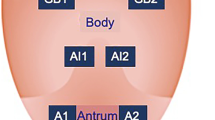Summary
Selection and follow-up of «high risk» population groups must be considered as the first step in cancer control. A project for mass screening for gastric cancer has been in process since 1968 by the Gastro-enterology Unit of the Regina Elena Institute for Cancer Research.
For the stomach, chronic gastritis with atrophic changes and intestinal metaplasia have shown a statistically significant association with cancer and represent, from a biological viewpoint, an almost mandatory step in carcinogenesis.
26.712 asymptomatic subjects were tested for stomach acidity in our Unit by simple laboratory examinations, and 4.432 who evidenced impaired acid secretion were submitted to blind abrasive gastric cytology by a special retractable nylon brush. Following the special parameters used for cytology, 709 of these subjects were classified as «high risk».
Endoscopic examinations performed on this latter group permitted us to show a very significant gastric pathology in comparison with the control group, including 8 cases of early gastric cancer, and one «in situ» carcinoma.
Besides this, the clinical, radiological and endoscopical examination performed on a population group of symptomatic subjects allowed us to diagnose 80 gastric cancers, 28 gastric ulcers, 15 cases of polyposis and 3 cases of Menetriere's disease.
The kind of mass-screening that we perform, clearly appears to give valuable results for early diagnosis of gastric cancer and for selection of «high risk» subjects.
Résumé
La sélection et la surveillance de groupes de population à «haut risque» doivent être considérées comme le premier pas pour le dépistage du cancer. Au sein du Service de gastroentérologie de l'Institut Regina Elena de Roma, un projet de dépistage pour le cancer gastrique est à l'étude depuis 1968.
Pour l'estomac, la gastrite chronique accompagnée d'atrophie et de métaplasie intestinale s'est avérée être associée d'une manière statiquement significative au cancer, et représente, également du point de vue biologique, une étape presque obligée de la carcinogenèse.
Au sein de notre Centre, l'acidité gastrique de 26 712 sujets asymptomatiques a été examinée à l'aide de simples examens de laboratoire, et 4 432 qui avaient une sécrétion acide diminuée ont été soumis à une étude cytologique abrasive de l'estomac. Selon les paramètres particuliers employés pour la cytologie, 709 de ces sujets ont été catalogués comme des «hauts risques».
Les examens endoscopiques pratiqués sur ce dernier groupe ont permis de découvrir une pathologie gastrique très significative, par rapport aux contrôles, y compris 8 cancers gastriques initiaux et 1 cancer «in situ».
Par contre, l'examen clinique, radiologique et endoscopique d'un groupe de population de sujets symptomatiques a permis de diagnostiquer 80 cancers de l'estomac, 28 ulcères gastriques, 15 cas de polypose et 3 cas de maladie de Ménétrier.
Le modèle de dépistage adopté semble donc bien en mesure de donner des résultats appréciables pour le diagnostic précoce du cancer et pour la sélection des sujets à «haut risque».
Similar content being viewed by others
Bibliography
CRESPI M., RICCI G. — Valutazione dell'acido cloridrico libero gastrico senza sondaggio.Epatologia, 1965,2, 239–243.
CRESPI M. BANI U., DE MEO S., CARNEVALI C. — Incidence of gastric secretory deficiency in a general population. Methods of detection, clinical and pathological significance.Proc. 8th. Intern. Congress of Gastroenterology, Prague, 1968.
CRESPI M., BANI U., BIGOTTI A. — Dépistage du cancer de l'estomac: possibilités actuelles et limites.Cmpt. rend. 1er Symp. Int. sur le dépistage du cancer. Spa., 1968.
CRESPI M., BIGOTTI A., DI MATTEO S. — The value of abrasive gastric cytology in the grading and follow-up of chronic gastritis.Gastrointestinal Endoscopy, pp. 227–229,Proc. of the 2nd World Congress of Gastrointestinal Endoscopy. Rome-Copenhagen, 1970.
CRESPI M., DI MATTEO S. — The diagnosis of the carcinoma of the stomach in its early phase.Archives Françaises des maladies de l'appareil digestif, 1972,61, 285–292.
CRESPI M. — Prevention and detection of gastric cancer.Proc. of the 2nd Int. Symp. on Cancer Detection and Prevention. Bologna, 1973.
DESCHNER E.E., WINAWER S.J., LIPKIN M. — Patterns of nucleic acid and protein synthesis in normal human gastric mucosa and atrophic gastritis.J. Nat. Cancer Inst., 1972,48, 1567–1574.
GLASS J.B. et al. — Gastric atrophy, atrophic gastritis and gastric secretory failure.Gastroenterology, 1960,39, 429.
HITCHCOCK C.R., SULLIVAN W.A., WANGENSTEEN O.H. — The value of achlorydria as a screening test for gastric cancer.Gastroe-terology, 1955,29, 621.
NIEBURGS H.E., JERZY GLASS J.B. — Gastric cells maturation disorders in atrophic gastritis, pernicious anemia and carcinoma.American J. Dig. Dis., 1963,8, 135.
RUBIN W. — Editorial: Intestine in the stomach. Transformation of the Gastric mucosa into an absorptive tissue.Gastroenterology, 1968,54, 116–118.
SI-CHUN MING, GOLDMAN H., FREIMAN D.G. — Intestinal metaplasia and histogenesis of carcinoma in human stomach.Cancer, 1967,20, 1418–1429.
SIURALA M., VARIS K., WILJASALO M. — Studies of patients with atrophic gastritis: a 10–15 years follow-up.Scand. J. Gastroent., 1966,1, 40.
STEMMERMANN G.N., HAYASHI T. — Intestinal metaplasia of the gastric mucosa; a gross and microscopic study of its distribution in various disease states.J. Nat. Cancer Inst., 1968,41, 627–633.
STRICKLAND R.G., MACKAY I.R. — A reappraisal of the nature and significance of chronic atrophic gastritis.Dig. Dis., 1973,18, 426–440.
WALKER I.R., STRICKLAND R.G., UNGAR B. and MACKAY I.R. — Simple atrophic gastritis and gastric carcinoma.Gut, 1971,12, 906–911.
WINAWER S.J., LIPKIN M. — Cell proliferation kinetics in the Gastrointestinal tract of man. IV. Cell renewal in the intestinalized gastric mucosa.J. Nat. Cancer Inst., 1969,42, 9–17.
Author information
Authors and Affiliations
Additional information
XIIIth S.M.I.E.R. International Congress, Lyon (France), 6–8/V1976.
About this article
Cite this article
Crespi, M., Casale, V., Grassi, A. et al. Results and prospectives of a mass-screening for gastric cancer and precancerous lesions of the stomach. Acta Endosc 8, 73–85 (1978). https://doi.org/10.1007/BF02970276
Published:
Issue Date:
DOI: https://doi.org/10.1007/BF02970276



